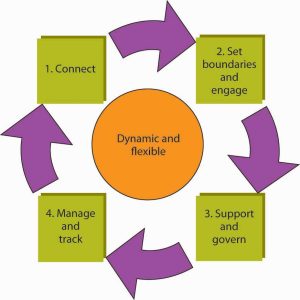11.4 Social Networks and Innovation
Learning Objectives
- Describe an innovation network and outline its four steps.
The Innovation Network
Strategy consultant McKinsey & Company points to research that finds differences in individual creativity and intelligence matter far less for organizational innovation than connections and networks. That is, networked employees can realize their innovations and make them catch on more quickly than nonnetworked employees can (Fleming & Marx, 2006).
On the basis of what was found by Cross and colleagues across many large firms, McKinsey has observed four important steps in the innovation network process (Barsh et al., 2007). These four critical steps in designing, implementing, and managing an innovation network are summarized in the following figure.

The first step, connect, involves the identification of key people in the organization with an innovation mind-set. Such individuals are not wed to the status quo and are comfortable with change and uncertainty. It is important to involve individuals with different backgrounds and approaches to innovation. For instance, some individuals are great at generating ideas while others may be better at researching and validating them. This group of individuals would then be defined as a network. The second step, set boundaries and engage, is where the network’s goals and objectives are defined. It is important to make it clear how the network’s goals and objectives will contribute to the organization’s goals and larger strategy, mission, and vision. Time frames and desired target outcomes are stated as well.
In the third step, support and govern, the leadership structure for the network is decided on, along with any protocols for meeting, sharing ideas, and decision making. With these process guidelines in place, the network members can then make sure that they have identified the resources necessary to conduct their work. This includes gaining sponsorship and buy-in from other parts of the organization, including top leadership. Finally, the fourth step involves managing and tracking. This last step covers a spectrum of needs, ranging from how network members will be recognized and rewarded for their contributions, the agreement about process-tracking criteria, and some guidelines on how new members join the network and others leave.
As mentioned in the connect stage of developing an innovation network, you can fine-tune the network’s goals by identifying the appropriate mix and balance of employees. Innovation networks, like cross-functional teams, require different skills and attitudes. In McKinsey’s experience, they include combinations of several archetypes. Which one are you?
- Idea generators prefer to come up with ideas, believe that asking the right questions is more important than having the right answers, and are willing to take risks on high-profile experiments.
- Researchers mine data to find patterns, which they use as a source of new ideas. They are the most likely members of the network to seek consumer insights and to regard such insights as a primary input.
- Experts value proficiency in a single domain and relish opportunities to get things done.
- Producers orchestrate the activities of the network. Others come to them for new ideas or to get things done. They are also the most likely members of the network to be making connections across teams and groups.
It would stand to reason that by making use of innovation networks, leaders would have access to creative individuals who are more likely to be open to change. We will see the importance of these networks in creating change in organizations. It is important to note that some social networks may be resistant to change, and how to overcome this issue.
“How Managers Can Use Social Networks to Create Value” in Principles of Management by OpenStax is licensed under under Creative Commons Attribution 4.0 International License.

